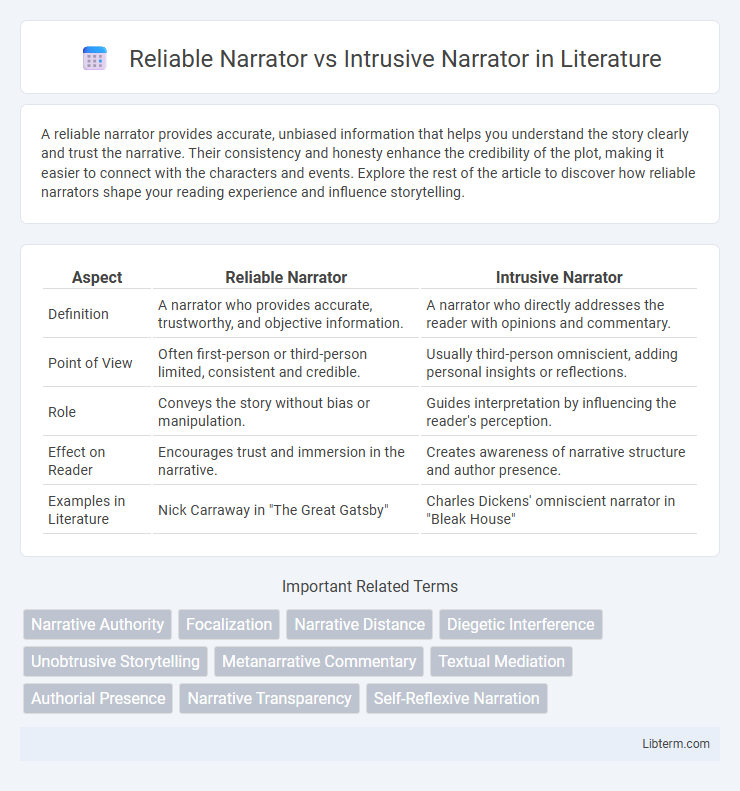A reliable narrator provides accurate, unbiased information that helps you understand the story clearly and trust the narrative. Their consistency and honesty enhance the credibility of the plot, making it easier to connect with the characters and events. Explore the rest of the article to discover how reliable narrators shape your reading experience and influence storytelling.
Table of Comparison
| Aspect | Reliable Narrator | Intrusive Narrator |
|---|---|---|
| Definition | A narrator who provides accurate, trustworthy, and objective information. | A narrator who directly addresses the reader with opinions and commentary. |
| Point of View | Often first-person or third-person limited, consistent and credible. | Usually third-person omniscient, adding personal insights or reflections. |
| Role | Conveys the story without bias or manipulation. | Guides interpretation by influencing the reader's perception. |
| Effect on Reader | Encourages trust and immersion in the narrative. | Creates awareness of narrative structure and author presence. |
| Examples in Literature | Nick Carraway in "The Great Gatsby" | Charles Dickens' omniscient narrator in "Bleak House" |
Defining the Reliable Narrator
The reliable narrator presents information consistently and truthfully, allowing readers to trust their perspective and interpret events accurately. This narrator typically maintains objectivity, clear knowledge of story facts, and a coherent, logical narrative voice. In contrast, an intrusive narrator disrupts the story flow by offering personal opinions, commentary, or explanations that influence reader perception beyond the characters' experiences.
Understanding the Intrusive Narrator
An intrusive narrator frequently breaks the narrative flow by directly addressing the reader, offering commentary or insights that shape the interpretation of the story. This narrative technique contrasts with a reliable narrator who presents events more objectively, allowing readers to form their own conclusions. Understanding the intrusive narrator involves recognizing their role in guiding, influencing, or challenging reader perception through overt authorial presence within the text.
Key Traits of Reliable Narration
Reliable narration presents a consistent and trustworthy perspective, characterized by accurate, objective, and clear storytelling that aligns with factual details and character motivations. This type of narrator maintains transparency, avoids misleading information, and allows readers to form their own interpretations without bias. Key traits include credibility, consistency in narrative voice, and an unobtrusive presence that prioritizes the story over authorial commentary.
Techniques of Intrusive Narration
Intrusive narration techniques include direct authorial commentary, frequent interruptions of the narrative, and addressing the reader personally to provide opinions or judgments. This style often breaks the fourth wall, blending storytelling with the narrator's subjective insights and cultural or philosophical reflections. Such methods create a distinct narrative voice that contrasts with a reliable narrator's transparent, objective delivery.
Impact on Reader Perception
A reliable narrator fosters trust, grounding readers in a consistent and believable narrative perspective that shapes clear understanding of characters and events. An intrusive narrator, by contrast, breaks the fourth wall with direct commentary or subjective judgments, prompting readers to critically question the story and engage more actively with the text. This narrative technique influences reader perception by creating distance or intimacy, subtly guiding interpretation and emotional response throughout the reading experience.
Narrative Trust and Credibility
Reliable narrators establish strong narrative trust by providing consistent, factual, and unbiased accounts, enhancing the story's credibility. Intrusive narrators, while offering subjective commentary or direct interaction with the reader, may compromise trust but can provide insightful context and depth. The balance between narrative trust and credibility hinges on the narrator's transparency and alignment with the story's internal logic.
Authorial Presence in Storytelling
A reliable narrator maintains objectivity and credibility, allowing the story to unfold through their consistent and trustworthy perspective without overt interference. An intrusive narrator, characterized by a strong authorial presence, frequently breaks the fourth wall to directly address the reader, inject commentary, and influence the narrative's tone and interpretation. This authorial presence shapes storytelling by blending narration with authorial voice, creating a dynamic interaction between the story and its audience.
Comparing Narrative Effects
A reliable narrator presents an accurate and consistent perspective, fostering trust and allowing readers to immerse themselves confidently in the story's reality. In contrast, an intrusive narrator actively engages the audience with commentary or judgments, shaping interpretation and highlighting thematic elements. This comparison enhances narrative effects by balancing credibility with authorial presence, influencing reader engagement and interpretive depth.
Notable Examples in Literature
Reliable narrators in literature offer consistent and trustworthy perspectives, exemplified by Nick Carraway in "The Great Gatsby," who provides clear observations within Jay Gatsby's world. Intrusive narrators, like the one in Jane Austen's "Emma," break the fourth wall to directly address readers, offering commentary and guiding interpretations beyond the story itself. These narrative styles shape reader engagement and influence the depth of thematic exploration in classic and modern novels.
Choosing the Right Narrator for Your Story
Selecting the right narrator involves distinguishing between a reliable narrator, who offers a trustworthy and consistent perspective, and an intrusive narrator, who breaks the fourth wall and directly addresses the reader with commentary or opinions. Reliable narrators enhance immersion by maintaining narrative credibility, while intrusive narrators create intimacy and can add humor or critical insight. Writers should consider their story's tone and purpose to decide if clarity and subtlety or direct engagement and commentary best serve their narrative goals.
Reliable Narrator Infographic

 libterm.com
libterm.com